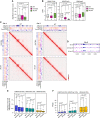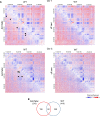Binding by the Polycomb complex component BMI1 and H2A monoubiquitination shape local and long-range interactions in the Arabidopsis genome
- PMID: 37070946
- PMCID: PMC10291032
- DOI: 10.1093/plcell/koad112
Binding by the Polycomb complex component BMI1 and H2A monoubiquitination shape local and long-range interactions in the Arabidopsis genome
Abstract
Three-dimensional (3D) chromatin organization is highly dynamic during development and seems to play a crucial role in regulating gene expression. Self-interacting domains, commonly called topologically associating domains (TADs) or compartment domains (CDs), have been proposed as the basic structural units of chromatin organization. Surprisingly, although these units have been found in several plant species, they escaped detection in Arabidopsis (Arabidopsis thaliana). Here, we show that the Arabidopsis genome is partitioned into contiguous CDs with different epigenetic features, which are required to maintain appropriate intra-CD and long-range interactions. Consistent with this notion, the histone-modifying Polycomb group machinery is involved in 3D chromatin organization. Yet, while it is clear that Polycomb repressive complex 2 (PRC2)-mediated trimethylation of histone H3 on lysine 27 (H3K27me3) helps establish local and long-range chromatin interactions in plants, the implications of PRC1-mediated histone H2A monoubiquitination on lysine 121 (H2AK121ub) are unclear. We found that PRC1, together with PRC2, maintains intra-CD interactions, but it also hinders the formation of H3K4me3-enriched local chromatin loops when acting independently of PRC2. Moreover, the loss of PRC1 or PRC2 activity differentially affects long-range chromatin interactions, and these 3D changes differentially affect gene expression. Our results suggest that H2AK121ub helps prevent the formation of transposable element/H3K27me1-rich long loops and serves as a docking point for H3K27me3 incorporation.
© American Society of Plant Biologists 2023. All rights reserved. For permissions, please e-mail: journals.permissions@oup.com.
Conflict of interest statement
Conflict of interest statement. The authors declare no competing interests.
Figures








Similar articles
-
H2A monoubiquitination in Arabidopsis thaliana is generally independent of LHP1 and PRC2 activity.Genome Biol. 2017 Apr 12;18(1):69. doi: 10.1186/s13059-017-1197-z. Genome Biol. 2017. PMID: 28403905 Free PMC article.
-
Kicking against the PRCs - A Domesticated Transposase Antagonises Silencing Mediated by Polycomb Group Proteins and Is an Accessory Component of Polycomb Repressive Complex 2.PLoS Genet. 2015 Dec 7;11(12):e1005660. doi: 10.1371/journal.pgen.1005660. eCollection 2015 Dec. PLoS Genet. 2015. PMID: 26642436 Free PMC article.
-
PWOs repress gene transcription by regulating chromatin structures in Arabidopsis.Nucleic Acids Res. 2024 Nov 27;52(21):12918-12929. doi: 10.1093/nar/gkae958. Nucleic Acids Res. 2024. PMID: 39526374 Free PMC article.
-
Chromatin modulation and gene regulation in plants: insight about PRC1 function.Biochem Soc Trans. 2018 Aug 20;46(4):957-966. doi: 10.1042/BST20170576. Epub 2018 Jul 31. Biochem Soc Trans. 2018. PMID: 30065110 Review.
-
Polycomb-mediated histone modifications and gene regulation.Biochem Soc Trans. 2024 Feb 28;52(1):151-161. doi: 10.1042/BST20230336. Biochem Soc Trans. 2024. PMID: 38288743 Review.
Cited by
-
Voice from both sides: a molecular dialogue between transcriptional activators and repressors in seed-to-seedling transition and crop adaptation.Front Plant Sci. 2024 Aug 6;15:1416216. doi: 10.3389/fpls.2024.1416216. eCollection 2024. Front Plant Sci. 2024. PMID: 39166233 Free PMC article. Review.
-
Epigenetics in the modern era of crop improvements.Sci China Life Sci. 2025 Jun;68(6):1570-1609. doi: 10.1007/s11427-024-2784-3. Epub 2025 Jan 8. Sci China Life Sci. 2025. PMID: 39808224 Review.
-
Promoter capture Hi-C identifies promoter-related loops and fountain structures in Arabidopsis.Genome Biol. 2024 Dec 31;25(1):324. doi: 10.1186/s13059-024-03465-7. Genome Biol. 2024. PMID: 39741350 Free PMC article.
-
Hi-GDT: A Hi-C-based 3D gene domain analysis tool for analyzing local chromatin contacts in plants.Gigascience. 2025 Jan 6;14:giaf020. doi: 10.1093/gigascience/giaf020. Gigascience. 2025. PMID: 40117178 Free PMC article.
-
Chromatin insulators: Good fences that make good neighbors.Plant Cell. 2025 Jul 1;37(7):koaf157. doi: 10.1093/plcell/koaf157. Plant Cell. 2025. PMID: 40515687 Free PMC article. No abstract available.
References
Publication types
MeSH terms
Substances
LinkOut - more resources
Full Text Sources
Molecular Biology Databases

